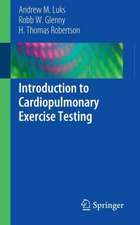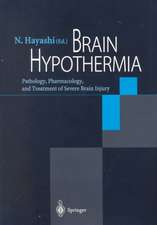Hemodynamic Monitoring: Lessons from the ICU
Editat de Michael R. Pinsky, Jean-Louis Teboul, Jean Louis Vincenten Limba Engleză Hardback – 12 mar 2019
The book is divided into distinguished sections: from physiology to pathophysiology; clinical assessment and measurements; and clinical practice achievements including techniques, the basic goals in clinical practice as well as the more appropriate hemodynamic therapy to be applied in different conditions. All chapters use a learning-oriented style, with practical examples, key points and take home messages, helping readers quickly absorbthe content and, at the same time, apply what they have learned in the clinical setting.
The European Society of Intensive Care Medicine has developed the Lessons from the ICU series with the vision of providing focused and state-of-the-art overviews of central topics in Intensive Care and optimal resources for clinicians working in Intensive Care.
Preț: 712.12 lei
Preț vechi: 749.60 lei
-5% Nou
Puncte Express: 1068
Preț estimativ în valută:
136.31€ • 148.11$ • 114.57£
136.31€ • 148.11$ • 114.57£
Carte tipărită la comandă
Livrare economică 17-23 aprilie
Preluare comenzi: 021 569.72.76
Specificații
ISBN-13: 9783319692685
ISBN-10: 3319692682
Pagini: 445
Ilustrații: XIX, 479 p. 94 illus., 73 illus. in color. With online files/update.
Dimensiuni: 168 x 240 x 29 mm
Greutate: 1.27 kg
Ediția:1st ed. 2019
Editura: Springer International Publishing
Colecția Springer
Seria Lessons from the ICU
Locul publicării:Cham, Switzerland
ISBN-10: 3319692682
Pagini: 445
Ilustrații: XIX, 479 p. 94 illus., 73 illus. in color. With online files/update.
Dimensiuni: 168 x 240 x 29 mm
Greutate: 1.27 kg
Ediția:1st ed. 2019
Editura: Springer International Publishing
Colecția Springer
Seria Lessons from the ICU
Locul publicării:Cham, Switzerland
Cuprins
Introduction (Jukka Takala).- Part I. Physiology and Pathophysiology.- Chapter 1. Shock: definition and recognition (Massimo Antonelli).- Chapter 2. Assessing the adequacy of cardiac output (Jean-Louis Vincent).- Chapter 3. The determinants of Venous Return (Maurizio Cecconi).- Chapter 4. Arterial blood Pressure Regulation (Michel Pinsky).- Chapter 5. Pulmonary Circulation (Marco Maggiorini).- Chapter 6. Heart Rate (Paul Marik).- Chapter 7. Autonomic Dysfunction in Shock (Gareth Ackland).- Chapter 8. Oxygen Delivery (Luciano Gattinoni).- Chapter 9. Mitochondrial Function (Mervyn Singer).- Chapter 10. Perioperative Hemodynamics (Andrew Rhodes).- Chapter 11. Haemodynamics and Extracorporeal Circulation (Alain Combes).- Part II. Clinical Assessment and Measurements.- Chapter 12. Clinical Assessment of Hemodynamic Instability (Jan Bakker).- Chapter 13. Assessment of the microcirculation (Daniel De Backer).- Chapter 14. SvO2/ScVO2 (Zsolt Molnar).- Chapter 15. pcO2 gap (Ospina-Tascon).- Chapter 16. Lactate (Glenn Hernandez).- Part III. The Techniques.- Chapter 17. Cardiac Ultrasound Examination in Shock (Antoine Viellard Baron).- Chapter 18. Non Cardiac Ultrasound Signs in Shock (Paul Mayo).- Chapter 19. Central Venous Pressure (Sheldon Magder).- Chapter 20. Arterial Blood Pressure (Jean-Louis Teboul).- Chapter 21. Cardiac Output Monitors (Daniel Reuter).- Chapter 22. Volumetric Monitoring (Manu Malbrain).- Chapter 23. Assessment of Fluid Responsiveness (Xavier Monnet).- Chapter 24. Pulmonary Arterial Catheter (Didier Payen).- Chapter 25. Arterial Pressure Waveform Analysis Cardiac Output Monitoring (Ignacio Monge Garcia).- Chapter 26. Oesophageal Doppler (Monty Mythen).- Chapter 27. Bioimpedence / Bioreactance (Pierre Squara).- Chapter 28. Other Techniques (Jacques Duranteau).- Part IV. Basic Goals in Clinical Practice.-Chapter 29. Blood Pressure Targets in the initial stabilization (Pierre Asfar).- Chapter 30. Choosing the right vasopressor (Anthony Gordon).- Chapter31. Fluid Resuscitation (Anders Perner).- Part V. Choosing the Right Hemodynamic Therapy.- Chapter 32. In Acute Heart Failure (Alexandre Mebazaa).- Chapter 33. In Septic Shock(Claude Martin).- Chapter 34. In ARDS (Luciano Gattinoni).- Chapter 35. In Neurological Emergencies (Fabio Taccone).- Chapter 36. For Perioperative Optimisation (Rupert Pearse).- Chapter 37. In a Patient under ECMO (Richard Beale).
Recenzii
“It belongs on the bookshelf of medical students, residents, nurses, intensivists, and anesthesiologists. … This content-rich, easy-to-read book is definitely worth the investment of money and time. … I would dare to say that the book delivers much more than its title suggests.” (Getúlio R. de Oliveira Filho, Anesthesia & Analgesia, Vol. 129 (5), November, 2019)
“This multiauthored book describes not only hemodynamic monitoring, but also cardiopulmonary physiology and therapy for common circulatory problems seen in patients in the intensive care unit. … Postgraduate trainees and senior providers seeking a sophisticated review of cardiovascular care are an appropriate audience.” (David J. Dries, Doody's Book Reviews, July 26, 2019)
Notă biografică
Series Editors
Maurizio Cecconi is Head of Department Anaesthesia and Intensive Care Units, IRCCS Istituto Clinico Humanitas, Rozzano (MI), Italy and Professor of Anaesthesia and Intensive Care, Humanitas University, Pieve Emanuele (MI), Italy. His main fields of research are haemodynamic monitoring, haemodynamic optimisation and physiology of the critically ill patient. He has published extensively and has specific interest in haemodynamic monitoring and fluid management of the critically ill.
Daniel De Backer is Professor of Intensive Care at the Université Libre de Bruxelles, Brussels, Belgium Head of Intensive Care Departments of CHIREC Hospitals (Brussels and Braine l’Alleud-Waterloo). His main fields of investigation are severe sepsis, organ dysfunction, acute circulatory failure and its treatment (in particular vasoactive agents), haemodynamic monitoring, hepato-splanchnic circulation and microcirculatory disorders.
Volume Editors
Michael R. Pinsky has published >300 peer-reviewed papers, >250 chapters, and 24 volumes. In the Department of Critical Care Medicine at the University of Pittsburgh, he is the program director for Adult Critical Care Medicine T32 research training program, Director of the Cardiopulmonary Research Laboratory, Editor-in-Chief of WebMD’s Critical Care Medicine and on numerous editorial boards. His research on heart lung interactions and resuscitation physiology has brought major advances in the management of critically ill patients.Jean Louis Teboul is a Professor of Therapeutics and Critical Care Medicine at Paris South University. He is pioneer in clinical application of heart-lung interactions, tissue oxygenation, haemodynamic monitoring, and assessment of volume status in critically ill patients. He proposed new tests to assess fluid responsiveness such as Pulse Pressure Variation and Passive Leg Raising.
Jean Louis Vincent is Professor of Intensive Care at University of Brussels. He is President of the World Federation of Societies of Intensive and Critical Care Medicine (WFSICCM) and a Past-President of the Belgian Society of Intensive Care Medicine (SIZ), the European Society of Intensive Care Medicine (ESICM), the European Shock Society
Daniel De Backer is Professor of Intensive Care at the Université Libre de Bruxelles, Brussels, Belgium Head of Intensive Care Departments of CHIREC Hospitals (Brussels and Braine l’Alleud-Waterloo). His main fields of investigation are severe sepsis, organ dysfunction, acute circulatory failure and its treatment (in particular vasoactive agents), haemodynamic monitoring, hepato-splanchnic circulation and microcirculatory disorders.
Volume Editors
Michael R. Pinsky has published >300 peer-reviewed papers, >250 chapters, and 24 volumes. In the Department of Critical Care Medicine at the University of Pittsburgh, he is the program director for Adult Critical Care Medicine T32 research training program, Director of the Cardiopulmonary Research Laboratory, Editor-in-Chief of WebMD’s Critical Care Medicine and on numerous editorial boards. His research on heart lung interactions and resuscitation physiology has brought major advances in the management of critically ill patients.Jean Louis Teboul is a Professor of Therapeutics and Critical Care Medicine at Paris South University. He is pioneer in clinical application of heart-lung interactions, tissue oxygenation, haemodynamic monitoring, and assessment of volume status in critically ill patients. He proposed new tests to assess fluid responsiveness such as Pulse Pressure Variation and Passive Leg Raising.
Jean Louis Vincent is Professor of Intensive Care at University of Brussels. He is President of the World Federation of Societies of Intensive and Critical Care Medicine (WFSICCM) and a Past-President of the Belgian Society of Intensive Care Medicine (SIZ), the European Society of Intensive Care Medicine (ESICM), the European Shock Society
Textul de pe ultima copertă
This book, part of the European Society of Intensive Care Medicine textbook series, teaches readers how to use hemodynamic monitoring, an essential skill for today’s intensivists. It offers a valuable guide for beginners, as well as for experienced intensivists who want to hone their skills, helping both groups detect an inadequacy of perfusion and make the right choices to achieve the main goal of hemodynamic monitoring in the critically ill, i.e., to correctly assess the cardiovascular system and its response to tissue oxygen demands.
The book is divided into distinguished sections: from physiology to pathophysiology; clinical assessment and measurements; and clinical practice achievements including techniques, the basic goals in clinical practice as well as the more appropriate hemodynamic therapy to be applied in different conditions. All chapters use a learning-oriented style, with practical examples, key points and take home messages, helping readers quickly absorb the content and, at the same time, apply what they have learned in the clinical setting.
The European Society of Intensive Care Medicine has developed the Lessons from the ICU series with the vision of providing focused and state-of-the-art overviews of central topics in Intensive Care and optimal resources for clinicians working in Intensive Care.
The European Society of Intensive Care Medicine has developed the Lessons from the ICU series with the vision of providing focused and state-of-the-art overviews of central topics in Intensive Care and optimal resources for clinicians working in Intensive Care.
Caracteristici
Complete overview of the topic with practice-oriented indications Thorough and invaluable “from-diagnosis-to-treatment” guide for residents in IC medicine All chapters include both theoretical explanations and take home messages Includes top-quality literature reviews that can be easily digested and used at the bedside to improve patients’ outcomes Edited and written by internationally respected experts in the field



































